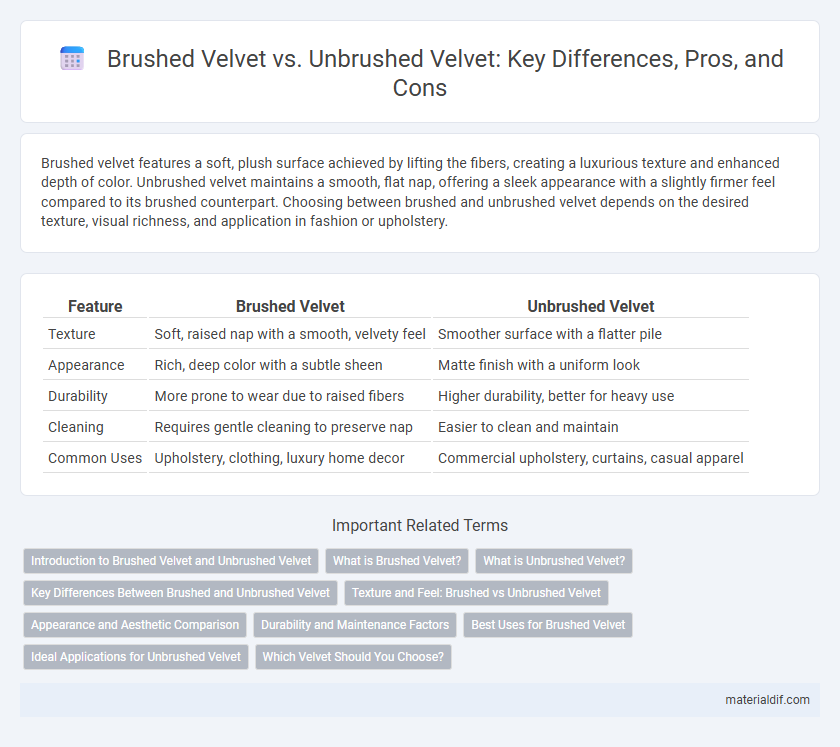Brushed velvet features a soft, plush surface achieved by lifting the fibers, creating a luxurious texture and enhanced depth of color. Unbrushed velvet maintains a smooth, flat nap, offering a sleek appearance with a slightly firmer feel compared to its brushed counterpart. Choosing between brushed and unbrushed velvet depends on the desired texture, visual richness, and application in fashion or upholstery.
Table of Comparison
| Feature | Brushed Velvet | Unbrushed Velvet |
|---|---|---|
| Texture | Soft, raised nap with a smooth, velvety feel | Smoother surface with a flatter pile |
| Appearance | Rich, deep color with a subtle sheen | Matte finish with a uniform look |
| Durability | More prone to wear due to raised fibers | Higher durability, better for heavy use |
| Cleaning | Requires gentle cleaning to preserve nap | Easier to clean and maintain |
| Common Uses | Upholstery, clothing, luxury home decor | Commercial upholstery, curtains, casual apparel |
Introduction to Brushed Velvet and Unbrushed Velvet
Brushed velvet features a soft, raised nap created by brushing the fabric's surface, enhancing its plush texture and warmth. Unbrushed velvet retains a smooth, flat nap, offering a sleek and slightly more durable finish. Understanding the distinction between brushed and unbrushed velvet is essential for selecting the right fabric based on tactile preference and end-use applications.
What is Brushed Velvet?
Brushed velvet is a type of velvet fabric where the surface fibers have been gently brushed to create a soft, plush texture and a slightly matte finish. This process enhances the fabric's tactile appeal and adds depth to its color by lifting the pile, making it smoother and more luxurious than unbrushed velvet. Unlike unbrushed velvet, which has a dense, uniform pile with a glossy sheen, brushed velvet offers a more muted, velvety feel ideal for upholstery and fashion applications.
What is Unbrushed Velvet?
Unbrushed velvet is characterized by its smooth, dense surface created without the traditional brushing process that raises the pile. This type of velvet has a more matte finish and a firmer texture compared to brushed velvet, making it ideal for upholstery and garments that require durability and a sleek appearance. The absence of brushing preserves the tight weave and subtle sheen, enhancing the fabric's strength and resistance to wear.
Key Differences Between Brushed and Unbrushed Velvet
Brushed velvet features a raised, soft nap achieved by polishing its surface, resulting in a smoother texture and richer appearance compared to unbrushed velvet, which maintains a flat, matte finish with a denser pile. The brushing process enhances velvet's sheen and tactile appeal, making brushed velvet more suitable for upholstery and fashion applications that demand a plush feel. Unbrushed velvet, being less reflective and textured, is often preferred for structured garments and decor needing a subtler, vintage look.
Texture and Feel: Brushed vs Unbrushed Velvet
Brushed velvet features a distinct, soft nap created by raising and shearing the fibers, resulting in a plush texture with a smooth, velvety feel that enhances comfort and luxury. Unbrushed velvet retains the natural state of the fabric's pile, providing a firmer, slightly rougher texture with a matte finish, offering durability and a more structured appearance. The choice between brushed and unbrushed velvet affects tactile experience and visual depth, influencing suitability for upholstery, fashion, or decor applications.
Appearance and Aesthetic Comparison
Brushed velvet features a smooth, velvety surface with a slightly raised nap that enhances its rich, lustrous appearance, making it ideal for luxurious upholstery and fashion design. Unbrushed velvet, lacking the raised nap, has a flatter and more matte finish, offering a subtle, understated elegance suitable for minimalist interiors and modern garments. The choice between brushed and unbrushed velvet significantly impacts texture depth and light reflection, influencing the overall aesthetic and tactile experience.
Durability and Maintenance Factors
Brushed velvet has a soft, plush texture due to the raised fibers, offering enhanced durability as the brushing process strengthens the fabric and makes it more resistant to wear. Unbrushed velvet features a smooth, flat pile that can be more prone to crushing and marks, requiring gentler maintenance to preserve its appearance. Regular cleaning and careful handling of brushed velvet reduce pilling and matting, while unbrushed velvet demands more delicate care to avoid fiber damage and maintain its luxurious sheen.
Best Uses for Brushed Velvet
Brushed velvet features a soft, smooth texture created by raising the fabric's nap, making it ideal for upholstery, curtains, and clothing that require a luxurious feel and enhanced durability. Its plush surface enhances color depth and provides a comfortable, warm touch, perfect for fashion garments like jackets and evening wear or home decor items where softness and elegance are desired. The gentle brushing process also improves the fabric's resistance to crushing, ensuring longevity in high-traffic applications.
Ideal Applications for Unbrushed Velvet
Unbrushed velvet features a smooth, lustrous surface with a more delicate texture, making it ideal for applications requiring a refined, elegant appearance such as evening wear, upholstery for formal settings, and luxury accessories. Its subtle sheen enhances visual appeal without the matte finish of brushed velvet, providing a sophisticated touch to high-end fashion and interior design projects. Unbrushed velvet's resilience and smooth grain also make it suitable for decorative drapery and delicate cushions that benefit from a polished, sleek texture.
Which Velvet Should You Choose?
Brushed velvet features a soft, plush surface created by raising the fibers, offering a luxurious feel and richer color depth, ideal for upholstery and fashion where texture and warmth matter. Unbrushed velvet has a smoother, less textured finish with a more muted sheen, suitable for structured garments or decor requiring a subtle elegance. Choose brushed velvet for tactile richness and vibrant appearance, while unbrushed velvet suits applications prioritizing sleekness and understated sophistication.
Brushed Velvet vs Unbrushed Velvet Infographic

 materialdif.com
materialdif.com